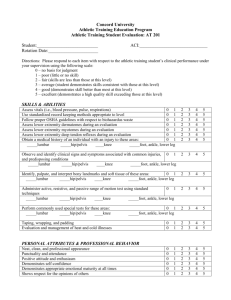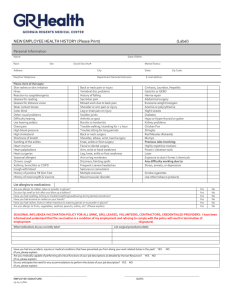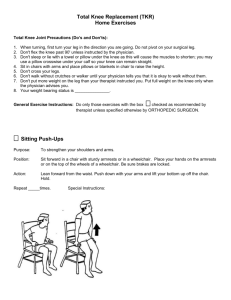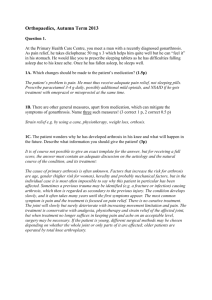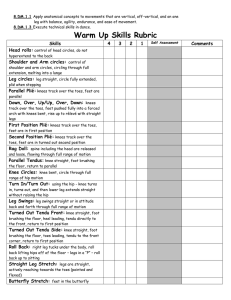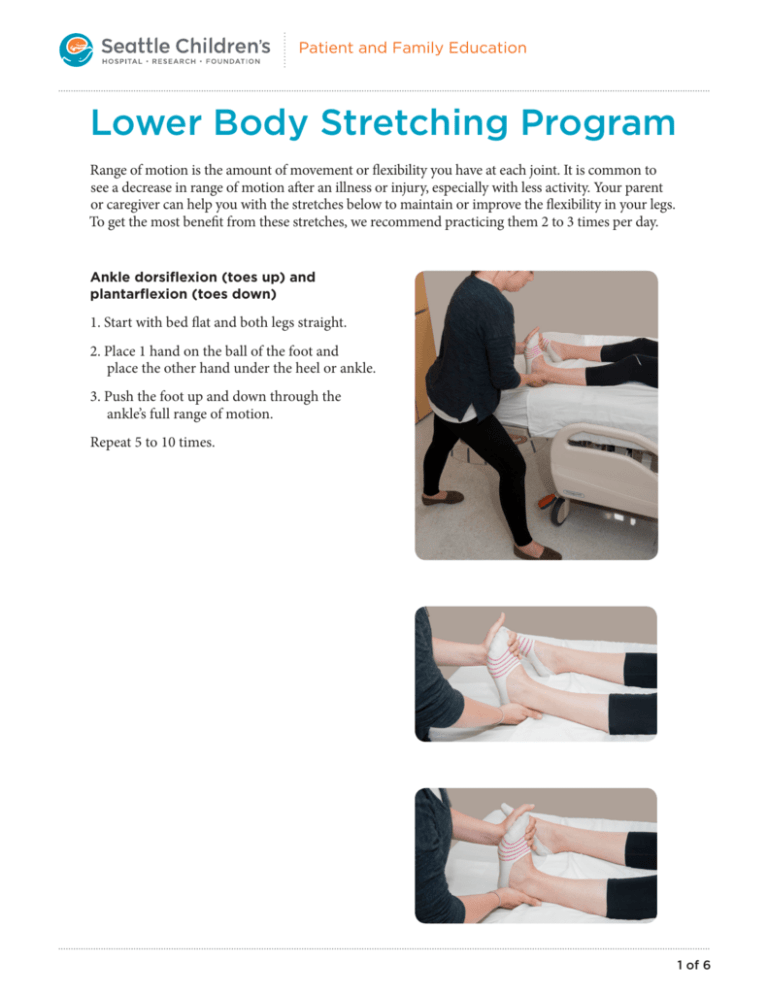
Patient and Family Education
Lower Body Stretching Program
Range of motion is the amount of movement or flexibility you have at each joint. It is common to
see a decrease in range of motion after an illness or injury, especially with less activity. Your parent
or caregiver can help you with the stretches below to maintain or improve the flexibility in your legs.
To get the most benefit from these stretches, we recommend practicing them 2 to 3 times per day.
Ankle dorsiflexion (toes up) and
plantarflexion (toes down)
1.Start with bed flat and both legs straight.
2.Place 1 hand on the ball of the foot and
place the other hand under the heel or ankle.
3.Push the foot up and down through the
ankle’s full range of motion.
Repeat 5 to 10 times.
1 of 6
Lower Body Stretching Program
Calf stretch
1. Start with bed flat and both legs straight.
2. Place 1 hand on the ball of the foot and
place the other hand under the heel or
ankle.
• Alternative hand positioning (see second
photo on right): Cup the heel with your
hand and press your forearm into the ball of
the foot. Place the other hand on top of the
knee to keep it straight.
3. Then, push the foot up as far as you can to
stretch the calf muscle.
4. Hold it for 30 to 60 seconds.
Repeat 3 times.
2 of 6
Lower Body Stretching Program
Hip and knee flexion (bend) and
extension (straighten)
1. Start with bed flat and both legs straight.
2. Place 1 hand under the heel and place the
other hand under the knee.
3. Bend the knee up toward the chest, moving
your hand to the front of the knee as you
push into full hip and knee flexion.
4. Straighten the leg back out to the start
position, moving your hand back under the
knee to support the leg.
Repeat 5 to 10 times.
3 of 6
Lower Body Stretching Program
Hamstring Stretch
1. Start with bed flat and both legs straight.
2. Place 1 hand under the heel and place the other hand on top of
the knee to help keep it straight.
3. Lift the leg up to stretch the muscle on the back of the thigh.
4. You may need to place 1 knee up on the bed to get close to
your child’s leg so you don’t strain your arms or back.
5. You may also rest the stretching leg on your shoulder and use
your upper body to push the leg up into a better stretch.
6. Hold it for 30 to 60 seconds.
Repeat 3 times.
4 of 6
Lower Body Stretching Program
Hip rotation (in and out)
1. Start with bed flat and legs straight.
2. Place 1 hand under the heel and place the
other hand under the knee.
3. Move the leg up until it is bent at 90 degrees
at the hip and 90 degrees at the knee.
4. Move your top hand to the top, outside of
the knee.
5. Picture a line pointing straight down
through the knee. This will be the center
point for this exercise.
6. Move the lower leg inward through its full
range of motion, keeping the knee in a
stable position.
7. Move the lower leg outward through its full
range of motion, keeping the knee in a
stable position.
Repeat 5 to 10 times.
5 of 6
Lower Body Stretching Program
Hip abduction (leg out) and hip
adduction (leg in)
1. Start with bed flat and both legs straight.
2. Place 1 hand under the heel and place the
other hand under the knee.
3. Move the leg out to the side through its full
range of motion.
4. Move the leg back in to the start position.
Repeat 5 to 10 times.
To Learn More
Free Interpreter Services
• Occupational / Physical Therapy
206-987-2113
• In the hospital, ask your child’s nurse.
• From outside the hospital, call the toll-free
Family Interpreting Line, 1-866-583-1527. Tell
the interpreter the name or extension you need.
• Ask your child’s healthcare provider
•www.seattlechildrens.org
Seattle Children’s offers interpreter services for Deaf, hard of hearing or non-English speaking patients, family members and
legal representatives free of charge. Seattle Children’s will make this information available in alternate formats upon request.
Call the Family Resource Center at 206-987-2201.
This handout has been reviewed by clinical staff at Seattle Children’s. However, your child’s needs are unique. Before you act
or rely upon this information, please talk with your child’s healthcare provider.
© 2015 Seattle Children’s, Seattle, Washington. All rights reserved.
Occupational and Physical Therapy
7/15
PE2141
of 66
66 of



